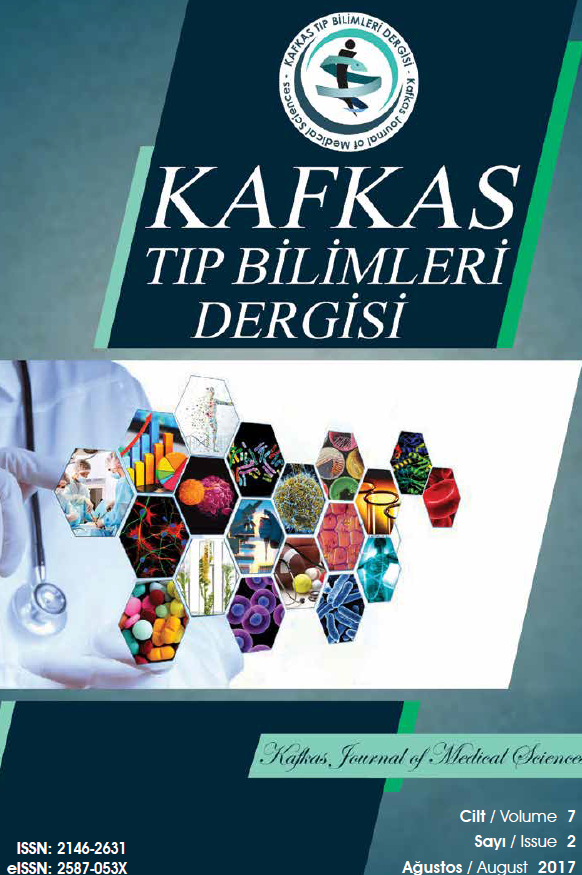Is the Success and Safety of Retrograde Intrarenal Surgery Related to the Opacity Status of Kidney Stones? A Critical Evaluation
Is the Success and Safety of Retrograde Intrarenal Surgery Related to the Opacity Status of Kidney Stones? A Critical Evaluation
opaque, non-opaque, RIRS, kidney stones,
___
- 1. Doizi S, Traxer O. Flexible ureteroscopy: technique, tips and tricks. Urolithiasis 2018; 46(1):47–58.
- 2. Singal RK, Denstedt JD. Contemporary management of ureteral stones. Urol Clin North Am. 1997;24(1):59–70.
- 3. Quhal F, Seitz C. Guideline of the guidelines: urolithiasis. Curr Opin Urol. 2021;31(2):125–9.
- 4. Türk C, Petřík A, Sarica K, Seitz C, Skolarikos A, Straub M, et al. EAU Guidelines on Interventional Treatment for Urolithiasis. Eur Urol. 2016;69(3):475–82.
- 5. Chung DY, Kang DH, Cho KS, Jeong WS, Jung H do, Kwon JK, et al. Comparison of stone-free rates following shock wave lithotripsy, percutaneous nephrolithotomy, and retrograde intrarenal surgery for treatment of renal stones: A systematic review and network meta-analysis. PLoS One. 2019;14(2).
- 6. Violette PD, Szymanski KM, Anidjar M, Andonian S. Factors determining fluoroscopy time during ureteroscopy. J Endourol. 2011;25(12):1837–40.
- 7. Tepeler A, Nakada SY. Radiology imaging for ureteral stones. In: Patel SR, Nakada SY, editors. Ureteral stone management: a practical approach. Published online January 1, 2015. Springer: London, New York; 2015. pp. 21–8.
- 8. Secker A, Rassweiler J, Neisius A. Future perspectives of flexible ureteroscopy. Curr Opin Urol. 2019;29(2):113–7.
- 9. Kennish SJ, Bhatnagar P, Wah TM, Bush S, Irving HC. Is the KUB radiograph redundant for investigating acute ureteric colic in the non-contrast enhanced computed tomography era? Clin Radiol. 2008;63(10):1131–5.
- 10. Levine JA, Neitlich J, Verga M, Dalrymple N, Smith RC. Ureteral calculi in patients with flank pain: correlation of plain radiography with unenhanced helical CT. Radiology. 1997;204(1):27–31.
- 11. Gücük A, Üyetürk U, Öztürk U, Kemahli E, Yildiz M, Metin A. Does the Hounsfield unit value determined by computed tomography predict the outcome of percutaneous nephrolithotomy? J Endourol. 2012;26(7):792–6.
- 12. Chua ME, Gomez OR, Sapno LD, Lim SL, Morales ML. Use of computed tomography scout film and Hounsfield unit of computed tomography scan in predicting the radio-opacity of urinary calculi in plain kidney, ureter and bladder radiographs. Urol Ann. 2014;6(3):218–23.
- 13. Huang CC, Chuang CK, Wong YC, Wang LJ, Wu CH. Useful prediction of ureteral calculi visibility on abdominal radiographs based on calculi characteristics on unenhanced helical CT and CT scout radiographs. Int J Clin Pract. 2009;63(2):292–8.
- 14. Heilberg IP. Treatment of patients with uric acid stones. Urolithiasis. 2015;44(1):57–63.
- 15. Trinchieri A, Montanari E. Prevalence of renal uric acid stones in the adult. Urolithiasis. 2017;45(6):553–62.
- 16. Tanik S, Zengin K, Albayrak S, Atar M, Imamoglu MA, Bakirtas H, et al. The effectiveness of flexible ureterorenoscopy for opaque and non-opaque renal stones. Urol J. 2015;12(1):20059.
- 17. Maghsoudi R, Etemadian M, Kashi AH, Ranjbaran A. The Association of Stone Opacity in Plain Radiography with Percutaneous Nephrolithotomy Outcomes and Complications. Urol J. 2016;13(6):2899–902.
- 18. Xiao Y, Li D, Chen L, Xu Y, Zhang D, Shao Y, et al. The R. I. R. S. scoring system: An innovative scoring system for predicting stone-free rate following retrograde intrarenal surgery. BMC Urol. 2017;17(1).
- 19. Sarikaya S, Senocak C, Selvi I, Ozbek R, Bozkurt OF. Does the use of fluoroscopy really affect the success rate of retrograde intrarenal surgery? Arch Esp Urol. 2018;71(9):772–81.
- 20. Vassileva J, Zagorska A, Basic D, Karagiannis A, Petkova K, Sabuncu K, et al. Radiation exposure of patients during endourological procedures: IAEA-SEGUR study. J Radiol Prot. 2020;40(4):1390–405.
- 21. Mahmood SN, Toffeq H, Fakhralddin S. Sheathless and fluoroscopy-free retrograde intrarenal surgery: An attractive way of renal stone management in high-volume stone centers. Asian J Urol. 2020 Jul 1;7(3):309–17.
- 22. Kirac M, Kopru B, Ergin G, Kibar Y, Biri H. Is fluoroscopy necessary during flexible ureteroscopy for the treatment of renal stones? Arab J Urol. 2019;18(2):112–7.
- ISSN: 2146-2631
- Yayın Aralığı: Yılda 3 Sayı
- Başlangıç: 2011
- Yayıncı: Kafkas Üniversitesi
Clinical Case Hidden in Young Patient is Ischemic Stroke
İbrahim YAĞCI, Ali İNALTEKİN, Muammer KARAKAYALI
Regional Anesthesia in Ophthalmic Surgery
Ahmet ŞEN, Tuğcehan SEZER AKMAN
Ümit YILDIRIM, Mehmet EZER, Mehmet USLU, Rasim GÜZEL, Kemal SARICA
Yasemen ADALİ, Kenan BİNNETOĞLU, Hatice BEŞEREN, Hasan ÇANTAY, Turgut ANUK, Tülay DİKEN ALLAHVERDİ, Barlas SÜLÜ, Doğan GÖNÜLLÜ
Determination of Mental Health Status of Nurses Caring for Patients With COVID-19
Vitamin D, Vitamin B12 and Ferritin Levels in Children Presenting with Malnutrition Complaints
Muammer KARAKAYALI, Timor OMAR, İnanç ARTAÇ, İbrahim RENCÜZOĞULLARI, Yavuz KARABAĞ, Şerif HAMİDEYİN, Mehmet ALTUNOVA
İnanç ARTAÇ, Timor OMAR, Muammer KARAKAYALI, Doğan İLİŞ, Öztürk DEMİR, Mehmet Hakan ŞAHİN, Yavuz KARABAĞ, İbrahim RENCÜZOĞULLARI
Mehmet USLU, Ümit YILDIRIM, Mehmet EZER, İsmet Bilger ERİHAN, Bumin ÖRS
